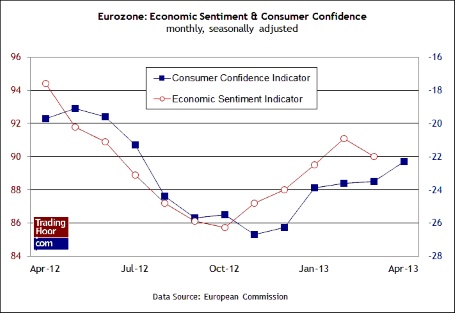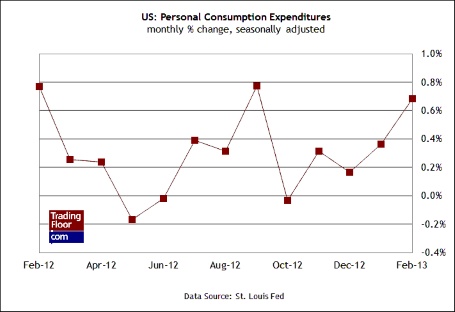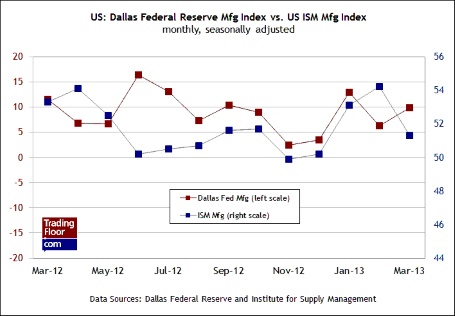The European Commission is updating its Economic Sentiment Index today, followed by the March report on personal income and spending in the U.S. Later, the U.S. Dallas Fed releases the latest review of manufacturing activity in the bank’s region, offering another clue for anticipating Wednesday’s ISM Manufacturing report.
EU Economic Sentiment (09:00 GMT): Today’s update on the mood across the eurozone will shape expectations for the week ahead, including Thursday's monetary policy announcement from the European Central Bank. Today's report follows in the wake of last week’s unexpected decline in Germany’s private sector output, based on the April PMI data (pdf). Given that wobbly backdrop, no one will be surprised if the Economic Sentiment Indicator (ESI) - a composite of business and consumer sentiment surveys - beats a hasty retreat in this month’s estimate. ESI’s March release hinted at weakness, with this sentiment index slipping modestly, the first decrease since last October.
Consumer confidence in the eurozone continued to rise in last week’s April estimate, according to the European Commission. Is that a sign that broad economic sentiment can hold up in today’s ESI report? It’s a bit odd to see the mood among consumers improving amid renewed worries that Europe’s recession may threaten Germany’s modest expansion after all. Is that a pressing risk? Today’s ESI release may provide some context for coming up with an answer.
U.S. Personal Income & Spending (12:30 GMT): Retail sales declined in March, sliding the most in nine months. That’s a hint that we’ll see a sharp slowdown in last month's personal consumption spending—a broader measure of consumer activity—in today’s release. But the consensus forecast still sees a mild 0.1 percent gain, albeit one that's well below the 0.7 percent rise reported for February.
The March comparisons in several key indicators have been weak relative to January and February, and so today’s update isn't likely to shock.The question is whether the softer data is more than a temporary rough patch? We’ll know more after today’s spending report. A bigger-than-expected slowdown would be worrisome at this point. But the range of forecasts from economists leaves room for optimism. According to one survey of dismal scientists, the worst-case scenario is a 0.1 percent decline in personal spending for March. Meanwhile, my econometric modeling implies a 0.2 percent gain. 
U.S. Dallas Fed Manufacturing Index (14:30 GMT): Today’s update from the Dallas Fed offers another clue for thinking about the ISM Manufacturing Index scheduled for release on Wednesday. Although regional manufacturing data is necessarily limited for dropping hints about the national trend, big moves carry more weight for discerning the overall trend. The issue today is deciding if the U.S. manufacturing sector is still growing after a shaky March. Several previously released regional manufacturing surveys for April raise some doubts.
If today’s numbers from the Dallas Fed are sharply lower, it’ll be harder to assume that the national counterpart via the ISM data will deliver an upbeat report on Wednesday. Keep in mind that last week’s flash PMI report for April from Markit Economics posted a slower rate of growth. Analysts are expecting something similar today for the Dallas Fed’s general business activity index, which implies that the production index (shown below) will also retreat. It seems that the early data so far is leaning toward the idea that the March slowdown has carried over into April. 
- English (UK)
- English (India)
- English (Canada)
- English (Australia)
- English (South Africa)
- English (Philippines)
- English (Nigeria)
- Deutsch
- Español (España)
- Español (México)
- Français
- Italiano
- Nederlands
- Português (Portugal)
- Polski
- Português (Brasil)
- Русский
- Türkçe
- العربية
- Ελληνικά
- Svenska
- Suomi
- עברית
- 日本語
- 한국어
- 简体中文
- 繁體中文
- Bahasa Indonesia
- Bahasa Melayu
- ไทย
- Tiếng Việt
- हिंदी
EU Sentiment, U.S. Personal Income, Dallas Fed
Published 04/29/2013, 01:27 AM
Updated 03/19/2019, 04:00 AM
EU Sentiment, U.S. Personal Income, Dallas Fed
3rd party Ad. Not an offer or recommendation by Investing.com. See disclosure here or
remove ads
.
Latest comments
Install Our App
Risk Disclosure: Trading in financial instruments and/or cryptocurrencies involves high risks including the risk of losing some, or all, of your investment amount, and may not be suitable for all investors. Prices of cryptocurrencies are extremely volatile and may be affected by external factors such as financial, regulatory or political events. Trading on margin increases the financial risks.
Before deciding to trade in financial instrument or cryptocurrencies you should be fully informed of the risks and costs associated with trading the financial markets, carefully consider your investment objectives, level of experience, and risk appetite, and seek professional advice where needed.
Fusion Media would like to remind you that the data contained in this website is not necessarily real-time nor accurate. The data and prices on the website are not necessarily provided by any market or exchange, but may be provided by market makers, and so prices may not be accurate and may differ from the actual price at any given market, meaning prices are indicative and not appropriate for trading purposes. Fusion Media and any provider of the data contained in this website will not accept liability for any loss or damage as a result of your trading, or your reliance on the information contained within this website.
It is prohibited to use, store, reproduce, display, modify, transmit or distribute the data contained in this website without the explicit prior written permission of Fusion Media and/or the data provider. All intellectual property rights are reserved by the providers and/or the exchange providing the data contained in this website.
Fusion Media may be compensated by the advertisers that appear on the website, based on your interaction with the advertisements or advertisers.
Before deciding to trade in financial instrument or cryptocurrencies you should be fully informed of the risks and costs associated with trading the financial markets, carefully consider your investment objectives, level of experience, and risk appetite, and seek professional advice where needed.
Fusion Media would like to remind you that the data contained in this website is not necessarily real-time nor accurate. The data and prices on the website are not necessarily provided by any market or exchange, but may be provided by market makers, and so prices may not be accurate and may differ from the actual price at any given market, meaning prices are indicative and not appropriate for trading purposes. Fusion Media and any provider of the data contained in this website will not accept liability for any loss or damage as a result of your trading, or your reliance on the information contained within this website.
It is prohibited to use, store, reproduce, display, modify, transmit or distribute the data contained in this website without the explicit prior written permission of Fusion Media and/or the data provider. All intellectual property rights are reserved by the providers and/or the exchange providing the data contained in this website.
Fusion Media may be compensated by the advertisers that appear on the website, based on your interaction with the advertisements or advertisers.
© 2007-2024 - Fusion Media Limited. All Rights Reserved.
